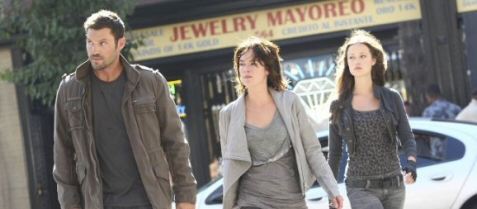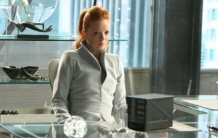- Sci-Fi
- 2008
- Buy the DVD
All photos © FOX
Reviewed by Will Harris
()
ho would’ve expected that the TV series spawned by the “Terminator” film franchise would actually prove to be a more enthralling piece of storytelling than the subsequent addition to said franchise (“Terminator Salvation”)? Granted, the fact that the movie was being helmed by McG set our alarm bells ringing, and we feared that it might prove to be more about special effects than substance, but still, the casting of Christian Bale as John Connor allowed us to get our hopes up. Big mistake. In the end, sci-fi fans in search of a product which blended technology, humanity, and even a little bit of spirituality were far more likely to find bliss through weekly viewing of “The Sarah Connor Chronicles.”
At the end of our review for Season One, we issued a teasing threat to executive producer Josh Friedman that the show’s sophomore season was going to have to be good to allow us to get past the fact that the show’s resident good-guy Terminator, Cameron (Summer Glau), acted like the perfect high school student in the opening scene of the series’ first episode, only to drop into oblivious android mode – think Data in the first season “Star Trek: The Next Generation” – immediately thereafter. Well, Friedman certainly shut us up, and part of the way he did it was to follow through a cliffhanger from the Season One finale, wherein Cameron was caught in an exploding van. It was a given that she was going to survive, but not long after we saw her crawling from the wreckage to the tune of Shirley Manson’s version of “Samson and Delilah,” we discovered that she was suffering from a serious chip malfunction. It didn’t take long for John to repair the damage, but it proved only to be a temporary fix, and her issues would recur throughout the season, most notably in “Allison from Palmdale,” wherein she found herself taking on the approximate memories of future resistance fighter Allison Young, on whom she’d originally been patterned. In addition, Glau had the opportunity to explore some deeper facets of Cameron’s programming, particularly in “Self Made Man,” which explores what the Terminator does with her evenings. (Hint: it isn’t in any way what you’d expect from a killing machine.)
Given the inevitability of Cameron’s survival, the big reveal in the aforementioned season premiere actually ended up being the introduction of Catherine Weaver (Shirley Manson), the co-founder and current CEO of ZeiraCorp – except that, as we discovered immediately prior to the closing credits, she isn’t actually Catherine Weaver at all. She’s a shape-shifting T-1001. The early episodes of the season had us mildly annoyed that we were being teased: we’d been given a character with awesome abilities, but we were rarely getting to see them in use. As the season progressed, however, her physical transformation became less interesting than her emotional evolution. See, it turns out that the real Catherine Weaver had a daughter named Savannah (Mackenzie Smith), and the T-1001 ended up maintaining the façade of her new identity in its entirety, keeping the child around and trying to understand her. “Catherine” also learns about humanity through her new employee. I believe you may remember FBI agent James Ellison (Richard T. Jones)?

If so, then you’ll also recall the Terminator named Cromartie (Garret Dillahunt) from Season One, whose evolution of the course of Season Two proves almost as fascinating as the T-1001’s. First, he’s taken down, has his chip destroyed, and is buried in the desert. Within a few episodes, however, his casing – I mean, it’s not really a body, you know? – is connected to ZeiraCorp’s artificial intelligence known as the Babylon A.I., taking over Cromatie’s physical form, at which point he receives a new moniker: John Henry. The interactions between John Henry and the others in his vicinity – Ellison, Savannah, and the T-1001 – are when the spirituality of the series really kicks in, with his newfound sentience bringing into question matters of life and death and whether they truly apply to a machine.
Well, here we are at the beginning of the review’s fifth paragraph, and we’ve barely spoken of the show’s title character. In truth, though, Sarah Connor may have given the series its title, but she really isn’t the driving force of the show, aside from the fact that she’s devoted to the cause of saving the future. Her relationship with John does provide some emotional heft to the events of the season, of course, but it’s more from the lingering effects of her actions. Her insistence at keeping John safe drives him to find love outside of his home, which is how he comes to fall for schoolmate Riley Dawson (Leven Rambin). Boy, that storyline was full of twists and turns, particularly with how it managed to tie into the romance between Derek Reese (Brian Austin Green) and fellow resistance member Jesse Flores (Stephanie Jacobsen), but if we try to explain what went on there, we’ll be here all day – and we’ll ruin half the fun of the season.
“Terminator: The Sarah Connor Chronicles” really upped the ante from its first season, gradually becoming must-see sci-fi TV. There were certainly moments which defied credibility, but when you’re dealing with a show that lives and dies by time travel, suspension of disbelief and acceptance of pretty much everything that’s handed to you is a necessity. Fortunately, Josh Friedman and company found a way to combine the necessary technological components of “Terminator” with deep characterization. So, of course, it was cancelled just as those who’d followed it from the beginning were really feeling rewarded for their steadfast viewership. And after the relative failure of “Salvation” at the box office, there’s every reason to believe that we may never know the fate of this show’s version of John Connor. Still, at least we scored a few happy endings in the midst of the series-ending cliffhanger.
Special Features: There are four audio commentaries, but you can’t really say that they’re spread throughout the set, as they appear only on Disc 1 (season premiere “Samson and Delilah” and Episode 2.4, “Allison from Palmdale”) and Disc 6 (“Adam Raised a Cain” and “Born to Run,” a.k.a. the final two episodes of the series). They do, however, variously provide nice insights from stars Lena Headey, Thomas Dekker, Summer Glau, and Shirley Manson, as well as executive producers Josh Friedman, James Middleton, and John Wirth. There’s also a gag reel, but the pièce de résistance of the set is the eight-part series of featurettes about the series: “Write the Future” (the writing process), “Conceptualization” (the visual effects challenges), “Designing Destruction” (combining real-world locations and futuristic sets), “Choreographic Chaos” (the teamwork among the stunt coordinator, second unit director, and special effects supervisor), “War Stories” (a collection of the season’s highlights), “Setting the Tempo” (detailing Bear McCreary’s score), and “Motivations” (where the cast and producers analyze the creation of their characters).
 |
 |
 |
 |
 |
 |
You can follow us on Twitter and Facebook for content updates. Also, sign up for our email list for weekly updates and check us out on Google+ as well.













